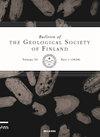基于高分辨率激光雷达数据的地貌学解释,库萨莫冰瓣东部的演化
IF 1.3
4区 地球科学
Q2 GEOLOGY
引用次数: 2
摘要
在这篇文章中,我们提供了来自芬兰东部库萨莫冰原(KIL)东部的新的冰川地貌数据。重点是冰川线理(约9000个个体特征)和基于流线型侵蚀和沉积构造、丘状和棱状冰碛以及冰川河流构造的冰瓣演化解释。冰川地貌测绘是根据芬兰地质调查局新的冰川动力学数据库,根据激光雷达数据的解释和分类进行的。结果表明,现代表层矿床形成于三个不同的冰流阶段。最古老的遗迹被视为偶尔出现的NW-SE巨石和未分类的冰川地貌和侵蚀山谷,代表了中魏克塞尔冰川作用。较年轻的形态是由Tuopajärvi和Kuusamo冰流相的两个重叠的鼓点区形成的,起源于晚魏克塞利冰川作用。通过对不同侵蚀和沉积形成模式的分析,可以分离出冰流相,并估计最后一次冰消期间KIL的演化、冰下条件和质量平衡。形态解释表明,Tuopajärvi冰流阶段较大且均匀,而Kuusamo后期冰流阶段更集中、更窄且不均匀,遵循的扇型模式也受到融水通道系统的强调,包括侵蚀和沉积特征。此外,在两个边缘(北部和南部),部分冰块形成了停滞区。线理的长度也表明了冰川的流速和输送距离,在巨型线理和鼓点的情况下,这比在凹槽地形中更长。KIL西部(核心部分)的棱纹冰碛表明,在斯堪的纳维亚冰盖的核心区和晚冰分带附近,在寒冷的冰下条件下,与强烈的采石和短的运输距离有关,沉积环境非常不同。本文章由计算机程序翻译,如有差异,请以英文原文为准。
Evolution of the eastern part of the Kuusamo Ice Lobe, based on geomorphological interpretation of high-resolution LiDAR data
In this article, we present new glacial geomorphological data from the eastern part of the Kuusamo Ice Lobe (KIL) in eastern Finland. The focus is on glacial lineations (about 9000 individual features) and interpretation of ice lobe evolution based on streamlined erosional and depositional formations, hummocky and ribbed moraines and glaciofluvial formations. Glacial geomorphological mapping was performed based on interpretation and classification of LiDAR data according to the Geological Survey of Finland’s new Glacier Dynamic database. The results revealed that modern surficial deposits were formed during three different ice flow phases. The oldest remains are seen as occasional NW-SE megalineations and unclassified glacially lineated terrains and erosional valleys representing the Middle Weichselian glaciation. The younger morphologies were formed from the two overlapping drumlin fields of the Tuoppajärvi and Kuusamo ice flow phases, with origins in the Late Weichselian deglaciation. Analysis of different erosional and depositional formation patterns was used to separate ice flow phases and estimate the evolution, subglacial conditions and mass balance of KIL during the last deglaciation. The morphological interpretation revealed that the Tuoppajärvi ice flow stage was large and homogeneous, while the later Kuusamo ice flow stage was more concentrated, narrower and heterogeneous, following a fan-type pattern that is also emphasised by the meltwater channel systems, including both erosional and depositional features. Furthermore, on both margins (northern and southern), part of the ice masses formed stagnant areas. The length of the lineations also indicates both glacier flow velocity and transport distances, which in the case of megalineations and drumlins are longer than in the fluted terrain. Ribbed moraines in the western (core part) of KIL indicate a very different depositional environment relating to strong quarrying and short transport distances under cold-based subglacial conditions, near the core area and the late ice divide zone of the Scandinavian Ice Sheet.
求助全文
通过发布文献求助,成功后即可免费获取论文全文。
去求助
来源期刊
CiteScore
1.30
自引率
0.00%
发文量
5
审稿时长
>12 weeks
期刊介绍:
Bulletin of the Geological Society of Finland (BGSF) publishes research articles and short communications in all branches of geosciences. Contributions from outside Finland are welcome, provided that they contain material relevant to Finnish geology or are of general interest.

 求助内容:
求助内容: 应助结果提醒方式:
应助结果提醒方式:


